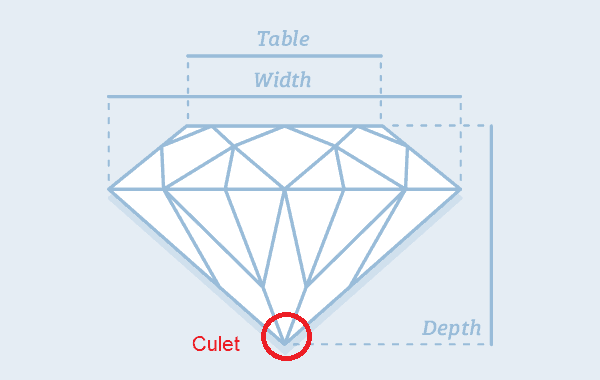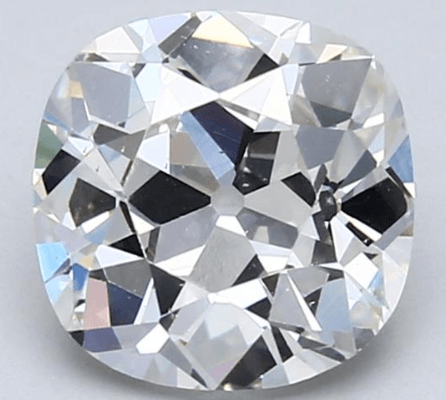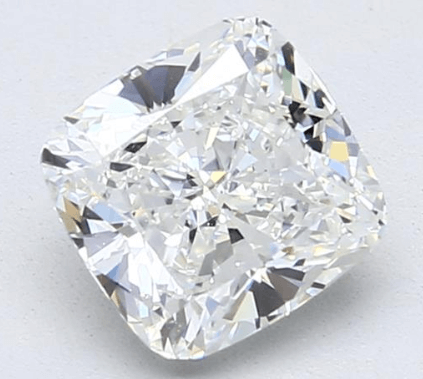A diamond culet is the tiny facet at the bottom of a diamond’s pavilion, serving as the tip or point where the gem’s facets converge. The culet is a critical but often overlooked feature of a diamond’s anatomy, influencing its overall appearance and brilliance. When purchasing a diamond, you may encounter various culet sizes ranging from “None” to “Very Large.” Ideally, a culet should be so small it appears as a pinpoint when viewed from the top, categorized as “None” or “Small” in grading reports. A larger culet can create a visual “hole” or dark spot at the bottom of the diamond, detracting from its overall brilliance and appearance.
In terms of pricing, the culet’s size can impact a diamond’s value but is generally not as significant a factor as the Four Cs (Carat, Cut, Clarity, and Color). However, a diamond with a larger or chipped culet could be priced lower due to these imperfections. Always consider the culet size in conjunction with other factors like cut grade and symmetry to ensure you’re getting a diamond that meets your aesthetic and budgetary needs.
Here’s what we’ll cover in this article:
How does a diamond culet affect the diamond’s appearance?
The grades of a diamond’s culet
Which diamond’s culet grade to choose
Why you should trust us
Bottom Line Recommendation
For most diamonds, you should limit your search only to diamonds with no culet (this is also referred to as a pointed culet). A diamond with a large culet grade won’t have the same brilliance, and the culet might be visible when you look at the diamond from above. Take a look at this diamond from Blue Nile It seems like a beautiful diamond and a pretty good value, but the culet makes this diamond a big no-no.
We recommend Blue Nile or James Allen. Blue Nile list the culet grade for all of their diamonds alongside the other diamond data, while James Allen provide GIA certificates that list the culet grade of their diamonds.
If you’ve looked at loose diamonds from a vendor like James Allen or Blue Nile, you may have noticed “culet” listed alongside factors such as cut, color, clarity and carat weight as part of the diamond’s details.
The culet of a diamond is the small, pointed area where the facets of the diamond meet at the bottom of the pavilion. In simple terms, it’s the bottom point, or tip, of the diamond.

Most diamonds have a pointed culet, meaning the facets of the pavilion all join at a sharp point at the base of the diamond. However, certain diamonds feature an additional facet at the culet that sits parallel to the diamond’s table.
Sound confusing? Below, we’ve explained more about what the culet of a diamond is, as well as how it can affect a diamond’s appearance and value. We’ve also shared our recommendations on what type of culet grade to look for when you’re shopping for a diamond.
How a Diamond’s Culet Affects Its Appearance
Culet essentially refers to the bottom point of a diamond. A diamond can either have a pointed culet (referred to a “no” culet on most grading reports) or a flat surface that adds an additional facet to the diamond.
Centuries ago, large culets were commonplace in most diamonds. For example, the Old Mine cut, which was popular in the Georgian and Victorian era, features a large culet. Another older cut, the Old European cut, also features a prominent, obvious culet.
Today, large culets are not a desirable feature in a diamond. Because the culet sits parallel to the table of a diamond, it provides an additional facet at the tip of the diamond through which light can escape, negatively affecting the diamond’s brilliance.

An overly large culet can even be visible to the naked eye when the diamond is viewed from above, creating the appearance of an inclusion in the diamond.
Furthermore, when a culet is off-center, it can affect the symmetry of a diamond and have a major negative impact on its appearance. As the American Gem Society explains: “When the table facet or the culet are not centered, the diamond can look off-center overall, depending on the severity.”
Diamond Culet Grades
Culet is one of several factors a gemologist will look at when grading a diamond. For the most part, diamonds with either a small culet or no culet at all are viewed as having a higher quality cut than diamonds with a large, visible culet.
Because the culet of a diamond is such a small area, a gemologist will typically view it with 10x magnification while grading the diamond.
When you view a diamond with a GIA certificate, the culet will be listed as one of several factors that contribute to the diamond’s cut grade. The International Diamond Grading System used by the GIA includes several different grades for culet size:
- None. A diamond with no culet facet will receive a grade of None. If all eight facets of the diamond’s pavilion meet each other, a diamond is often referred to as having a “pointed” culet.
- Very Small. A diamond with a culet of less than 1.5% of its average diameter is graded as having a Very Small culet.
- Small. A diamond with a culet of approximately 1.5% of its average diameter is graded as having a Small culet.
- Medium. A diamond with a culet of approximately 3% of its average diameter is graded as having a Medium culet.
- Slightly Large. A diamond with a culet of approximately 5% of its average diameter is graded as having a Slightly Large culet. A culet of this size is often visible to the naked eye in a mid-sized or large diamond.
- Large. A diamond with a culet of approximately 7% of its average diameter is graded as having a Large culet. A culet of this size is usually visible to the naked eye in a mid-sized diamond.
- Very Large. A diamond with a culet of approximately 11% of its average diameter is graded as having a Very Large culet. A Very Large culet will be easy to see when the diamond is viewed from above.
- Extremely Large. A diamond with a culet of 15% or more of its average diameter is graded as having an Extremely Large culet. An Extremely Large culet is very easy to see from the table of the diamond.
Which Culet Grade is Best?
Originally, the culet was added to a diamond to protect the stone. Although a diamond is very hard, the pointed tip at the bottom of a diamond can potentially break if the stone is hit with a large amount of force.
This is important for when the stone is being set. If the person setting the stone isn’t careful, a diamond with no culet could become damaged. For this reason, we recommend buying from a trusted vendor like James Allen or Blue Nile, both of whom mount their diamonds carefully.
These days, most diamonds don’t have an additional facet at the culet. Since a large culet can negatively affect the appearance of a diamond, it’s best to stick to diamonds that have no culet. This is often referred to as a pointed culet, as the bottom of the diamond has a point instead of a flat surface.
These grades all provide a diamond with optimal brilliance. As the culet is pointed, there’s no risk of you seeing it from the top of the diamond.

If you choose a diamond with a culet that’s graded Medium, Slightly Large or larger, it may appear as a small, dark dot when you view the diamond from the top. A culet of this size will also affect the diamond’s brilliance, meaning it won’t sparkle as impressively when light touches it.
Finding a Diamond’s Culet Grade
Any diamond that comes with GIA certification will have a culet grade. Some diamond vendors make this grade visible online, while others display it as part of a diamond’s GIA certificate:
- Blue Nile list the diamond’s culet grade in the “Diamond Details” section of any loose diamond page. You can also view the grade as part of the GIA certificate.
- James Allen don’t display each diamond’s culet grade on their website. However, you can request the GIA certificate for any GIA certified diamond, which includes the culet grade and more information.
- Leibish & Co., who specialize in fancy color diamonds, provide GIA certificates for most of their diamonds, which include a culet grade.
“Culet size is described as the width of the culet facet, when present, relative to a round diamond’s average girdle diameter. Descriptions include none, very small, small, medium, slightly large, large, very large, and extremely large.”
“Larger culets can have a negative effect on the diamond’s face-up appearance, specifically affecting its pattern, and lowering its cut grade.” Gemological Institute of America (GIA)
Conclusion
As a general rule, it’s best to choose a diamond that has a culet grade of “none” or “pointed.” Diamonds with these culet grades tend to have optimal brilliance and a better overall appearance than diamonds with a large and potentially visible culet.
Need help finding the perfect diamond? Contact us and our experts will help you find the highest quality diamond for your preferences and budget.

- No questions asked returns within 30 days of shipment. James Allen will send you a paid shipping label to return the ring.
- Lifetime Warranty
- Free International Shipping
- Free prong tightening, repolishing, rhodium plating and cleaning every 6 months
- Provide insurance appraisals
- One free resizing within 60 days of purchase
- Free ring inscriptions
- Best-in-class high quality imagery of all diamonds in stock
- 24/7 Customer Service
- Best-in-class packaging


- No questions asked returns within 30 days of shipment. Blue Nile will send you a paid shipping label to return the ring.
- Lifetime Warranty
- Free Shipping
- Free prong tightening, repolishing, rhodium plating and cleaning every 6 months
- Provide insurance appraisal
- One free resizing within the first year of purchase
- High quality images of about half of their diamonds
- 24/7 Customer Service
- 100% credit towards future upgrades (must be at least double in value)
- Best in class fulfillment

Still afraid of getting ripped off?
Before you buy a diamond, get personal buying advice from industry veterans. We'll help you get the best diamond for the money.
Ask your diamond purchase question here
DISCLAIMER: We don't use your email for marketing. Period.
You Might Like
Diamond Prices: A Complete Guide
A diamonds’ price is determined primarily by the 4 Cs of the diamond. On the wholesale level, diamond prices are first based on a diamond shape and
The Best Places to Buy Engagement Rings
Buying an engagement ring is often one of the first major purchases in a person's life. The process can be fraught with tension as there are so m
1 Carat Diamond Price & Buying Guide
A wide range of 1 carat diamonds exist both in online markets and local diamond jewelry stores. Not only are there significant differences in beauty



